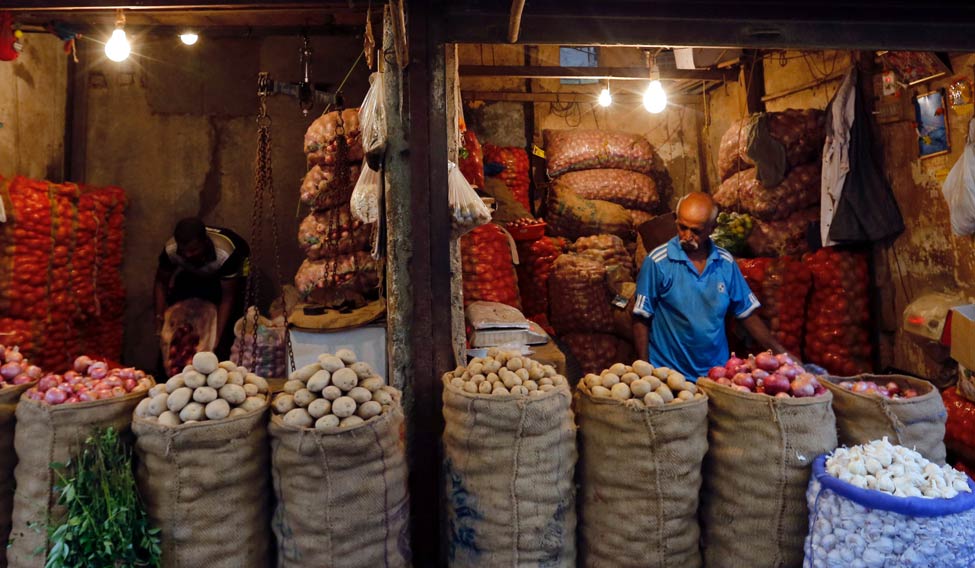India's wholesale price index (WPI) inflation fell sharply in May to 2.17 per cent, compared with 3.85 per cent in April as food prices continued to drop.
This mirrors inflation based on the consumer price index (CPI) for May, which declined to 2.18 per cent, its lowest level since 2012 when the government had begun measuring it on a nation-wide basis.
The figures for May were sharply lower than 2.99 per cent reported in April and 2.60 per cent economists had forecast in a Reuters poll. Core inflation, last month, also trended down to 4.1 per cent, versus 4.4 per cent in April.
The sharp drop has even surprised the Reserve Bank of India, which has targeted to contain retail inflation at 4 per cent, plus or minus 2 per cent.
The main reason behind a fall in inflation is a decline in food prices, particularly prices of pulses and vegetables. Additionally, prices of cereals, eggs, oils and spices too have helped.
Food inflation slipped to -1 per cent, compared to 0.6 per cent in April. Prices of pulses, which have been on a decline since August 2016 due to expansion in acreage, increased buffer stocks and imports, continued to contract in May, falling -1.8 per cent.
“We believe that there has been a structural shift in food prices (especially crops such as vegetables, fruits and pulses), due to government intervention in the form of curbs on hoarding, creating buffer stocks etc.,” said Suvodeep Rakshit, senior economist at Kotak Institutional Equities.
Helped by a good monsoon last year, India had a record harvest in 2016-17, with an estimated food grain production of 272 million tonnes. The agriculture ministry has set a production target of 273 million tonnes in the current financial year.
Sonal Varma, chief India economist at Nomura Securities attributes the drop in retail inflation to a sharp decline in pulse prices, which have dropped 22 per cent till May from their peak in July, and early data for June suggests the slide has continued.
“While food inflation has moderated, the extent is also being exaggerated due to the steep declines in pulses and vegetable prices. Excluding these two items, food inflation rose 3.6 per cent in May versus 4.2 per cent in April,” said Varma.
Nonetheless, the low inflation numbers have created considerable uncertainty to the evolving inflation trajectory for the next few months, said RBI.
“If the configurations evident in April are sustained, then absent policy interventions, headline inflation is projected in the range of 2.0-3.5 per cent in the first half of the year and 3.5-4.5 per cent in the second half,” the central bank said in its bi-monthly monetary policy review earlier this month.
Analysts expect the food inflation to remain low in the current financial year, but there are upside risks.
Ratings agency Crisil has forecast inflation at 4 per cent for the year-ending March 2018, versus 4.5 per cent in 2016-17.
“Yet, some upside risks can creep in on account of three factors. One, the pattern of rainfall distribution and impact on crop production. Two, the impact of revision in house rent allowance on inflation trajectory. Three, resilience in private consumption demand even during the demonetisation phase, and the fact that it is gaining strength as the postponed consumption bounces back,” said Dharmakirti Joshi, chief economist at Crisil.
Madan Sabnavis, chief economist at Care Ratings also said there are upside risks to inflation this year due to implementation of Goods and Services Tax and announcement of large farm loan waivers and higher deficits of states.
Some economists say, the sharp drop in inflation and a slowdown in industrial production have opened the door for the RBI to cut interest rate, although they are divided on the timing.
“We believe that May inflation, which surprised on the downside, is likely to be followed by a sub-2 per cent print in June and July. This will be below the lower band of RBI’s inflation target range of 2-6 per cent, which should give room for the RBI to accommodate. We expect the monetary policy committee to weigh towards a 25 bps rate cut in the August meeting,” said Kotak's Rakshit.
Sabnavis of Care also expects a 25 bps rate cut by RBI, but feels it is more likely in October, as inflation over the next couple of months would be dependent on monsoon, house rent allowances and implementation of GST.
Nomura's Varma, who has for long expected RBI to remain on pause mode throughout 2017, said there is a 40 per cent chance, the central bank could cut rate.
If the inflation remains low and well within the range, then that coupled with lower interest rates could boost consumption in the second half of the year, although it is likely to remain subdued in the near-term due to the lingering effects of demonetisation.
“Demonetisation did push back consumption by a few months. The cycle could pickup in the festive season (Sept-Nov) and once that happens, we could see private sector spending also picking up slowly,” said Sabnavis.






